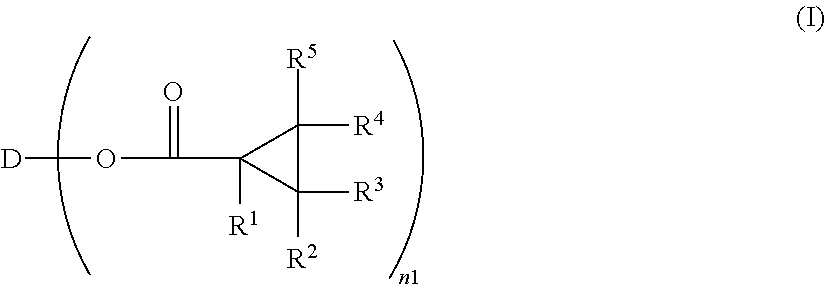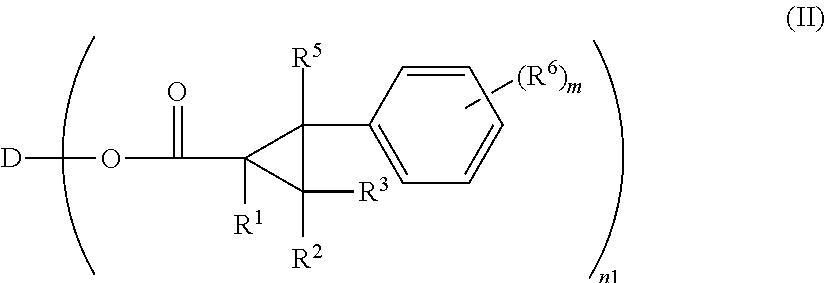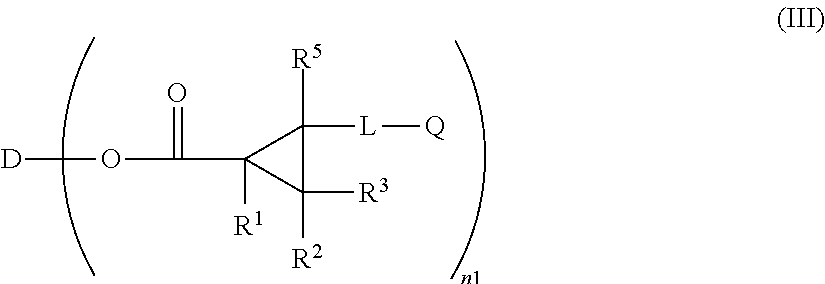Optically anisotropic material, liquid crystal display device and triphenylene compound
a liquid crystal display device and anisotropic material technology, applied in the direction of instruments, polarising elements, transportation and packaging, etc., can solve the problems of reducing the wavelength dispersion property, generating alignment defects at the boundary, and conventional discotic liquid crystal molecules cannot ensure the optical properties necessary, etc., to achieve the reduction of the color tint change of the displayed image, the effect of enlarge the viewing angle and large refractive index anisotropy
- Summary
- Abstract
- Description
- Claims
- Application Information
AI Technical Summary
Benefits of technology
Problems solved by technology
Method used
Image
Examples
synthesis example 1
[0147]Compound (1) was synthesized by the following route. The phase transition temperature is a measured value by the observation through a polarizing microscope (the same applies to Synthesis Example 2 and others in the following).
[0148]
[0149]In a nitrogen atmosphere, palladium acetate (0.42 g, 1.87 mmol) and tri(o-tolyl)phosphine (2.28 g, 7.49 mmol) were added to a triethylamine (200 ml) solution containing 4-bromophenol (32.3 g, 187 mmol) and tert-butyl acrylate (34 ml, 234 mmol), and the resulting solution was stirred at 90° C. for 4 hours. The obtained reaction solution was allowed to cool and after adding ethyl acetate and aqueous dilute hydrochloric acid, liquid-separated, and the organic phase was washed with aqueous dilute hydrochloric acid and saturated brine and then dried over anhydrous magnesium sulfate. Thereafter, the solvent was removed by distillation under reduced pressure, and the residue was purified by silica gel column chromatography using an ethyl acetate-hex...
synthesis example 2
[0156]Compound (2) was synthesized at a yield of 43% (5 steps) in the same manner as in Synthesis Example 1 except for changing dimethylsulfuric acid in Synthesis Example 1 to bromobutane.
[0157]1H NMR (400 MHz, CDCl3)
[0158]δ 0.99 (6H, t, J=7.2 Hz), 1.30-1.65 (30, m), 1.70-1.95 (18H, m), 2.05-2.15 (6H, m), 2.65-2.80 (6H, m), 3.94 (12H, t, J=6.4 Hz), 6.80 (12H, d, J=8.0 Hz), 7.01 (12H, d, J=8.0 Hz), 7.04 (12H, d, J=8.0 Hz), 8.22 (6H, s); mass spectrum (M+Na) / (POSI)=1632; phase transition temperature: Cry 75° C., Col 100° C., ND 197-210° C. Iso.
synthesis example 3
[0159]Compound (3) was synthesized by the following route.
[0160]
[0161]Concentrated sulfuric acid (20 ml) was added to an ethyl alcohol (1.5 L) solution of parahydroxycinnamic acid (200 g, 1.22 mol), and the resulting solution was refluxed for 6 hours. The obtained reaction solution was allowed to cool and after removing 1 L of ethyl alcohol by distillation under reduced pressure and adding ethyl acetate and saturated brine, liquid-separated, and the organic phase was neutralized with sodium bicarbonate water, washed with saturated brine and then dried over anhydrous magnesium sulfate. Thereafter, the solvent was removed by distillation under reduced pressure to obtain 226 g of (B-1) (yield: 97%).
[0162]Methoxyethoxymethyl chloride (MEMCl) (51.4 ml) was added to a methylene chloride (600 ml) solution of (B-1) (57.6 g, 0.3 mol) and then, diethylisopropylamine (78.4 ml, 0.45 mmol) was gradually added dropwise while keeping the temperature of the reaction system at 30° C. or less. In thi...
PUM
| Property | Measurement | Unit |
|---|---|---|
| thickness | aaaaa | aaaaa |
| thickness | aaaaa | aaaaa |
| thickness | aaaaa | aaaaa |
Abstract
Description
Claims
Application Information
 Login to View More
Login to View More - R&D
- Intellectual Property
- Life Sciences
- Materials
- Tech Scout
- Unparalleled Data Quality
- Higher Quality Content
- 60% Fewer Hallucinations
Browse by: Latest US Patents, China's latest patents, Technical Efficacy Thesaurus, Application Domain, Technology Topic, Popular Technical Reports.
© 2025 PatSnap. All rights reserved.Legal|Privacy policy|Modern Slavery Act Transparency Statement|Sitemap|About US| Contact US: help@patsnap.com



